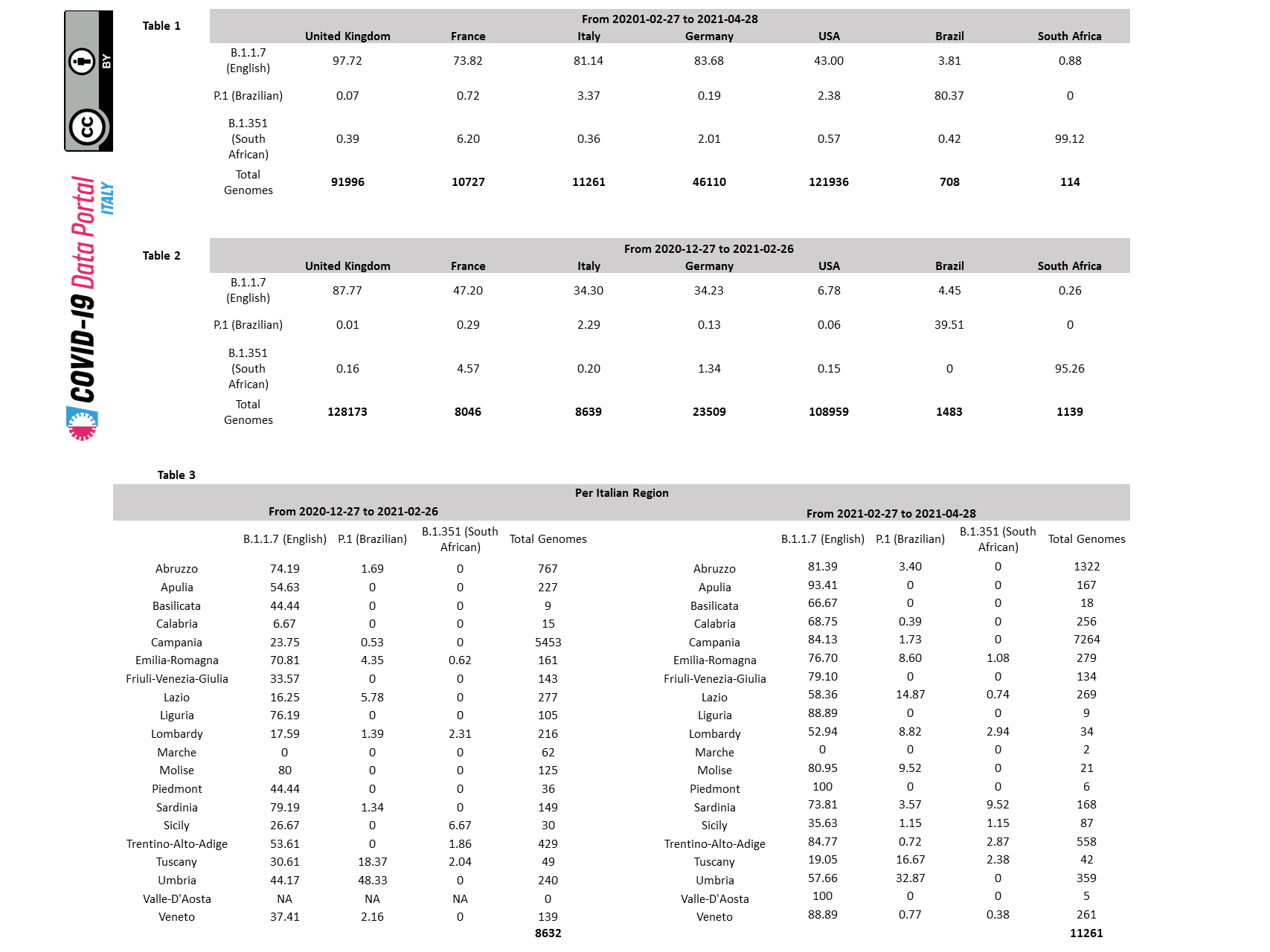Prevalence of SARS-CoV-2 lineages of potential epidemiological concern
Published: 10 May 2021
Two distinct non-overlapping time intervals are compared to illustrate the dynamics of circulation and or possible increases/decreases in the prevalence of these lineages. Table 1 incorporates data from February 27th (last update) to April 28th 2021, while Table 2 reports equivalent for the interval considered in the previous update (from December 27th 2020 to 26th February 2021).

The tables report the prevalence of three different lineages of SARS-CoV-2, known as the “English Variant” (B.1.1.7), “South African Variant” (B.1.351) and “Brazilian Variant” (P.1), that are considered to represent a potential risk and are under scrutiny by national and supranational health authorities. For these reasons they are defined as Variants of Concern or VOC.
Table 1 reports the prevalence of the three lineages in different countries (both European and extra-European) between February 27th and April 28th 2021.
Table 2 shows equivalent data but for the interval considered for the previous update (from December 27th 2020 to February 26th 2021). In both tables the last row indicates the total numbers of genomic sequences available at the time of analysis.
Table 3 reports equivalent data for different italian administrative regions. The column “Total genomes” reports the total number of genomes considered.
IMPORTANT: Since available data are fragmented and not homogeneous between different italian regions and different counties, the information reported in this analysis is purely descriptive, and does not necessarily represent the real.
IMPORTANT: despite being as complete and up to date as possible, the analyses here reported can not offer too precise overview of the real epidemiological situation. In fact, available data are fragmented and do not possess the same level of completeness and accuracy for different geographic regions. Increasing the number of viral genomes regularly sequenced and shared in public open access repositories, would be exential to improve the above-mentioned issue in the future.
Variants of potential epidemiological relevance
B.1.1.7 (English Variant)
B.1.1.7 was first detected in the South of the UK in mid-December 2020. This lineage is currently the predominant type of SARS-CoV-2 in the UK and in most European countries. B.1.1.7 has been shown to have higher transmissibility. Moreover preliminary observations suggest also a greater severity of the disease, although further experimental tests and clinical investigations are required.
As of April 27th 2021, B.1.1.7 presence was verified in 128 countries in the world.
Comparison between the values reported in Table 1 and Table 2, highlights a substantial increase in the prevalence of B.1.1.7 in Italy between February 27th and April 28th 2021 (from 34.30% to 81.14%). A similar growth trend was observed also in Germany (from 34.23% to 83.68%) and France (from 47.20% to 73.82%). Moreover, B.1.1.7 confirms itself to be the most relevant variant in the United Kingdom, where its prevalence further increased by 10%. Regarding extra-European countries, B.1.1.7 notably increased its prevalence in the United States (from 6.78% to 43%), whereas its presence remains extremely low in Brazil and South Africa.
Looking at data reported in Table 3 it is possible to deduce that, also taking in account the number of sequences available, B.1.1.7 diffusion does not seem uniform among different regions. Despite this it is still possible to observe a generalized increase in the prevalence of B.1.1.7.
Nevertheless, it is important to remark that data reported in Table 3 represent an estimate of the prevalence of B.1.1.7 based on currently available data. Despite the recent increase in the number of publicly available genomic sequences, data are still highly fragmented between different Italian regions, and a lack of homogeneity in genomic data collection and sharing is still observed. Furthermore, since specific initiatives were undertaken to sequence and monitor the spread of B.1.1.7 and VOC in general ascertainment biases can not be excluded.
P.1 (Brazilian Variant)
The P.1 lineage was first reported in Japan on January 19th 2021, where it was isolated in four travellers arriving from Brazil, and subsequently identified also in South Korea, again in travellers from the same country. Preliminary investigations in Manaus, Amazonas state, report an increase in the proportion of COVID-19 cases associated with P.1, from 52.2% (35/67) in December 2020 to 85.4% (41/48) in January 2021. This highlights ongoing local transmission and suggests potential greater transmissibility or propensity for reinfection, although available data are limited. There is no evidence of increased severity of the disease.
As of April 27th 2021, P.1 presence was verified in 45 countries in the world.
The comparison between Table 1 and Table 2 shows how this lineage became definitely predominant in Brazil (where it was firstly identified). In fact, P.1 prevalence increased from 39.51% (period from December 27th 2020 to February 26th 2021) to 80.37% (period from February 27th to April 28th 2021).
Regarding other countries considered in this analysis, a mild increase in the number of P.1 sequenced genomes was observed. The overall prevalence of this variant remains generally low.
B.1.351 (South African Variant)
The B.1.351 lineage (also known as 501Y.V2) was first identified in South Africa in December 2020, where it is currently the most widespread viral type. Preliminary data indicate that this lineage may also be characterized by greater transmissibility, while it is currently unclear whether it is associated with more severe clinical manifestations.
As of April 27th 2021, B.1.351 presence was verified in 70 countries in the world.
As it can be clearly observed from data reported in Table 1 and Table 2, B.1.351 shows a limited prevalence outside of South Africa where it represents the predominant lineage with a prevalence of about 99%.
Sources: GISAID (genomic data), ECDC (Variants of Concern), WHO (epidemiological data)